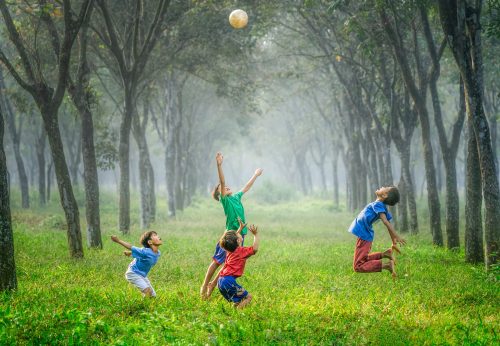The benefits of combining movement and stories. There is expert information online, studies, and research that point to the positive effects of using movement with stories, especially when it comes to education and child development.
It seems the following effects are possible from combining stories with movement (like yoga, of course, and yoga has a whole lot of other benefits for kids, too) Some studies are referenced at the end of this post.
Enhanced Engagement and Attention
Combining movement with stories increases engagement, especially in young children. Moving while listening to or reading a story helps maintain their attention and makes the learning experience more enjoyable.
Improved Comprehension
Physical movement can enhance understanding and comprehension of the story. Actions, gestures, and body language can help convey and reinforce the narrative’s content, making it easier for children to grasp complex concepts.
Vocabulary and Language Development
The use of movement can aid in vocabulary acquisition and language development. When children physically act out the actions described in a story, they internalize and remember words and phrases more effectively.
Enhanced Retention
Movement in conjunction with storytelling can enhance memory retention. Children tend to remember stories and information better when it is associated with a physical experience or action.
Social and Emotional Learning (For Groups … like Kids’ Yoga Classes)
Movement-based stories can foster social and emotional development. Children learn empathy, cooperation, and teamwork when they engage in activities that require group movements and interactions.
Cognitive Benefits
Movement can stimulate cognitive development, as it often involves problem-solving, critical thinking, and decision-making. These skills are enhanced when children need to perform specific movements as part of the storytelling experience.
Physical Activity and Health
Incorporating movement with stories encourages physical activity, which is beneficial for overall health. This can help combat sedentary behaviors and promote a more active lifestyle.
Multisensory Learning
Combining movement with storytelling engages multiple senses, making the learning experience more multisensory. This approach caters to various learning styles, allowing children with different preferences to benefit from the activity.
Stress Reduction
Movement and physical activity can help reduce stress and anxiety in children, creating a more positive and relaxed learning environment.
Creativity and Imagination
Movement-based storytelling encourages creativity and imagination. Children have the opportunity to visualize and interpret stories in their unique ways, fostering creative thinking.
Inclusivity (For Groups…like Kids’ Yoga Classes)
The use of movement with stories can be adapted to accommodate children with different abilities and needs. It can be a more inclusive way of teaching and engaging children.
Fun and Motivation
Movement adds an element of fun and excitement to the learning process, which can be motivating and increase children’s willingness to participate and learn.
While the research supports the positive effects of combining movement with stories, it is essential to consider the specific context, age group, and learning objectives. Educators and parents should tailor their approach to match the needs and interests of the children they are working with. Additionally, further research continues to explore the nuances and benefits of this approach in different educational and developmental settings.
Studies
This study offers promising evidence as to the efficacy of using drama-based storytime in preschool classrooms to support listening comprehension and recall of oral narratives. Findings support a theory of embodied language learning and suggest potential benefits of drama to enhance literacy learning.
Gesture like a kitten and you won’t forget your tale: Drama-based, embodied story time supports preschoolers’ narrative skills
Katie A. Bernstein a, Lauren van Huisstede a, Scott C. Marley a, Yuchan (Blanche) Gao a, Melissa Pierce-Rivera a c, Evan Ippolito a d, M. Adelaida Restrepo a e, Jenny Millinger b, Kathryn Brantley b, Jen Gantwerker
Early Childhood Research Quarterly
Volume 66, 1st Quarter 2024, Pages 178-190
https://www.sciencedirect.com/science/article/abs/pii/S0885200623001266
The results of this study demonstrate the efficacy of combining movement and story-telling, over movement or story-telling alone, to benefit both motor competence and language ability in pre-schoolers. Combining both movement and story-telling appears to offer synergistic benefits in relation to physical and communication development, which are critical for good development in the early years.
Duncan, M., Cunningham, A., & Eyre, E. (2019). A combined movement and story-telling intervention enhances motor competence and language ability in pre-schoolers to a greater extent than movement or story-telling alone. European Physical Education Review, 25(1), 221-235. https://doi.org/10.1177/1356336X17715772
Linear mixed model analyses revealed both the embodied learning and the physical activity condition as being more effective in teaching children new words than the control condition.
Embodied learning in the classroom: Effects on primary school children’s attention and foreign language vocabulary learning
Mirko Schmidt, Valentin Benzing, Amie Wallman-Jones, Myrto-Foteini Mavilidi, David Revalds Lubans, Fred Paas
Psychology of Sport and Exercise
Volume 43, July 2019, Pages 45-54
https://www.sciencedirect.com/science/article/abs/pii/S1469029218303145#preview-section-cited-by
Combining movement and storytelling activities boosts pre-school children’s key motor skills and language ability, according to experts who used the bestselling book ‘The Gruffalo’ during their research.
How ‘The Gruffalo’ helped academics boost youngsters’ motor skills and language ability
https://www.sciencedaily.com/releases/2017/06/170628095846.htm Michael Duncan, Anna Cunningham, Emma Eyre. A combined movement and story-telling intervention enhances motor competence and language ability in pre-schoolers to a greater extent than movement or story-telling alone. European Physical Education Review, 2017; 1356336X1771577 DOI: 10.1177/1356336X17715772
Early motor development has an important role in promoting physical activity (PA) during childhood and across the lifespan. Children from South Asian backgrounds are less active and have poorer motor skills, thus identifying the need for early motor skill instruction. This study examines the effect of a movement and storytelling intervention on South Asian children’s motor skills. Following ethics approval and consent, 39 children (46% South Asian) participated in a 12-week movement and storytelling intervention. Pre and post, seven motor skills (run, jump, throw, catch, stationary dribble, roll, and kick) were assessed using Children’s Activity and Movement in Preschool Study protocol. At baseline, South Asian children had poorer performance of motor skills. Following the intervention, all children improved their motor skills, with a bigger improvement observed for South Asian children. Early intervention provided remedial benefits to delays in motor skills and narrowed the motor skills gap in ethnic groups.
Keywords: motor skill instruction; fundamental movement skills; ethnicity; disadvantaged; locomotor; object control
Eyre, E.L.J.; Clark, C.C.T.; Tallis, J.; Hodson, D.; Lowton-Smith, S.; Nelson, C.; Noon, M.; Duncan, M.J. The Effects of Combined Movement and Storytelling Intervention on Motor Skills in South Asian and White Children Aged 5–6 Years Living in the United Kingdom. Int. J. Environ. Res. Public Health 2020, 17, 3391. https://doi.org/10.3390/ijerph17103391
Dr. John Ratey, author of Spark: The Revolutionary New Science of Exercise and the Brain, is often quoted for his research regarding the transformative effects of exercise on the brain. His book is a fascinating read and his website contains his TEDx talk, “Run, Jump, Learn! How Exercise can Transform our Schools,” a Brain Grains video that introduces us to children whose lives have been turned around through exercise, and a Mr. H. “The Exercise + Brain Rap” video
The Science Behind Exercise and the Brain
www.johnratey.com
Ursula the Roly Poly Unicorn: A Yoga-For-Kids Adventure about Self-Esteem and Loving Yourself Just as You Are
Photo credit: Photo by Robert Collins on Unsplash

